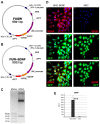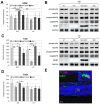Preclinical Evaluation of Long-Term Neuroprotective Effects of BDNF-Engineered Mesenchymal Stromal Cells as Intravitreal Therapy for Chronic Retinal Degeneration in Rd6 Mutant Mice
- PMID: 30759764
- PMCID: PMC6387230
- DOI: 10.3390/ijms20030777
Preclinical Evaluation of Long-Term Neuroprotective Effects of BDNF-Engineered Mesenchymal Stromal Cells as Intravitreal Therapy for Chronic Retinal Degeneration in Rd6 Mutant Mice
Abstract
This study aimed to investigate whether the transplantation of genetically engineered bone marrow-derived mesenchymal stromal cells (MSCs) to overexpress brain-derived neurotrophic factor (BDNF) could rescue the chronic degenerative process of slow retinal degeneration in the rd6 (retinal degeneration 6) mouse model and sought to identify the potential underlying mechanisms. Rd6 mice were subjected to the intravitreal injection of lentivirally modified MSC-BDNF or unmodified MSC or saline. In vivo morphology, electrophysiological retinal function (ERG), and the expression of apoptosis-related genes, as well as BDNF and its receptor (TrkB), were assessed in retinas collected at 28 days and three months after transplantation. We observed that cells survived for at least three months after transplantation. MSC-BDNF preferentially integrated into the outer retinal layers and considerably rescued damaged retinal cells, as evaluated by ERG and immunofluorescence staining. Additionally, compared with controls, the therapy with MSC-BDNF was associated with the induction of molecular changes related to anti-apoptotic signaling. In conclusion, BDNF overexpression observed in retinas after MSC-BDNF treatment could enhance the neuroprotective properties of transplanted autologous MSCs alone in the chronically degenerated retina. This research provides evidence for the long-term efficacy of genetically-modified MSC and may represent a strategy for treating various forms of degenerative retinopathies in the future.
Keywords: BDNF; MSC; OCT; lentiviral vectors; rd6; regenerative medicine; retinal degeneration; tissue imaging.
Conflict of interest statement
The authors declare no conflict of interest. The funders had no role in the design of the study; in the collection, analyses, or interpretation of data; in the writing of the manuscript, or in the decision to publish the results.
Figures






Similar articles
-
Long-term neuroprotective effects of NT-4-engineered mesenchymal stem cells injected intravitreally in a mouse model of acute retinal injury.Invest Ophthalmol Vis Sci. 2013 Dec 23;54(13):8292-305. doi: 10.1167/iovs.13-12221. Invest Ophthalmol Vis Sci. 2013. PMID: 24265016
-
Combined Transplantation With Human Mesenchymal Stem Cells Improves Retinal Rescue Effect of Human Fetal RPE Cells in Retinal Degeneration Mouse Model.Invest Ophthalmol Vis Sci. 2020 Jul 1;61(8):9. doi: 10.1167/iovs.61.8.9. Invest Ophthalmol Vis Sci. 2020. PMID: 32639552 Free PMC article.
-
Intravitreal Implantation of Genetically Modified Autologous Bone Marrow-Derived Stem Cells for Treating Retinal Disorders.Adv Exp Med Biol. 2016;854:571-7. doi: 10.1007/978-3-319-17121-0_76. Adv Exp Med Biol. 2016. PMID: 26427461 Free PMC article.
-
Mesenchymal stem cells and mesenchymal stem cell-derived exosomes: a promising strategy for treating retinal degenerative diseases.Mol Med. 2025 Feb 21;31(1):75. doi: 10.1186/s10020-025-01120-w. Mol Med. 2025. PMID: 39984849 Free PMC article. Review.
-
Brain-Derived Neurotrophic Factor as a Treatment Option for Retinal Degeneration.Adv Exp Med Biol. 2018;1074:465-471. doi: 10.1007/978-3-319-75402-4_57. Adv Exp Med Biol. 2018. PMID: 29721977 Review.
Cited by
-
Survival and Neurogenesis-Promoting Effects of the Co-Overexpression of BCLXL and BDNF Genes on Wharton's Jelly-Derived Mesenchymal Stem Cells.Life (Basel). 2022 Sep 9;12(9):1406. doi: 10.3390/life12091406. Life (Basel). 2022. PMID: 36143442 Free PMC article.
-
Drinking hydrogen water improves photoreceptor structure and function in retinal degeneration 6 mice.Sci Rep. 2022 Aug 10;12(1):13610. doi: 10.1038/s41598-022-17903-8. Sci Rep. 2022. PMID: 35948585 Free PMC article.
-
Mesenchymal Stem Cells as a Gene Delivery Tool: Promise, Problems, and Prospects.Pharmaceutics. 2021 Jun 7;13(6):843. doi: 10.3390/pharmaceutics13060843. Pharmaceutics. 2021. PMID: 34200425 Free PMC article. Review.
-
Perspectives and Limitations of Mesenchymal Stem Cell-Based Therapy for Corneal Injuries and Retinal Diseases.Cell Transplant. 2025 Jan-Dec;34:9636897241312798. doi: 10.1177/09636897241312798. Cell Transplant. 2025. PMID: 39856809 Free PMC article. Review.
-
Long-Term Effects of Adjuvant Intravitreal Treatment with Autologous Bone Marrow-Derived Lineage-Negative Cells in Retinitis Pigmentosa.Stem Cells Int. 2021 Jun 2;2021:6631921. doi: 10.1155/2021/6631921. eCollection 2021. Stem Cells Int. 2021. PMID: 34122558 Free PMC article.
References
MeSH terms
Substances
Grants and funding
LinkOut - more resources
Full Text Sources
Other Literature Sources
Molecular Biology Databases
Research Materials

